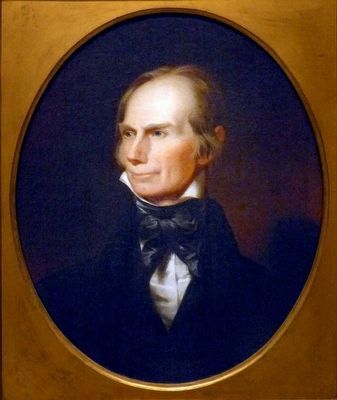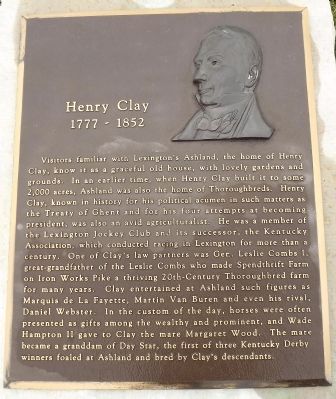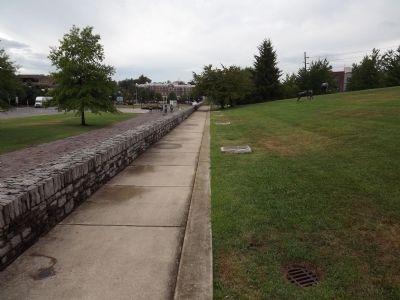Lexington in Fayette County, Kentucky — The American South (East South Central)
Henry Clay
1777 - 1852
Topics and series. This historical marker is listed in these topic lists: Animals • Entertainment • Sports. In addition, it is included in the Former U.S. Presidents: #08 Martin Van Buren series list.
Location. 38° 2.502′ N, 84° 29.407′ W. Marker is in Lexington, Kentucky, in Fayette County. Marker can be reached from the intersection of East Main Street (U.S. 60) and Midland Avenue (U.S. 60), on the right when traveling west. Located in Thoroughbred Park. Touch for map. Marker is at or near this postal address: 100 Midland Avenue, Lexington KY 40508, United States of America. Touch for directions.
Other nearby markers. At least 8 other markers are within walking distance of this marker. James Ben Ali Haggin (a few steps from this marker); Andrew Jackson (a few steps from this marker); Mrs. Henry Carnegie Phipps (a few steps from this marker); Col. Phil T. Chinn (a few steps from this marker); Allen Paulson (a few steps from this marker); Samuel D. Riddle (a few steps from this marker); John E. Madden (a few steps from this marker); Capt. Harry Guggenheim (a few steps from this marker). Touch for a list and map of all markers in Lexington.

Photographed By Allen C. Browne, August 9, 2015
3. Henry Clay
This 1842 portrait of Henry Clay by John Neagle hangs in the National Portrait Gallery in Washington DC.
“His admirers called him ‘Gallant Harry,‘ and his impetuous charm made him quite possibly the most beloved politician of his generation. But the real legacy of Kentucky's Henry Clay was his unstinting devotion, in the House of Representatives and later in the Senate, to maintaining a strong American union. In the early 1830s, as southern states threatened to nullify federal authority over a tariff bill that would have hurt plantation economies, Clay set aside his own preference for the new law to orchestrate a compromise. In 1850, with the North and South on the verge of armed conflict over the extension of slavery into the new western territories, Clay again stepped in with proposals that, temporarily at least, satisfied both sections. This last act of his career earned him the title of Great Pacificator.”
“His admirers called him ‘Gallant Harry,‘ and his impetuous charm made him quite possibly the most beloved politician of his generation. But the real legacy of Kentucky's Henry Clay was his unstinting devotion, in the House of Representatives and later in the Senate, to maintaining a strong American union. In the early 1830s, as southern states threatened to nullify federal authority over a tariff bill that would have hurt plantation economies, Clay set aside his own preference for the new law to orchestrate a compromise. In 1850, with the North and South on the verge of armed conflict over the extension of slavery into the new western territories, Clay again stepped in with proposals that, temporarily at least, satisfied both sections. This last act of his career earned him the title of Great Pacificator.”
Credits. This page was last revised on October 27, 2020. It was originally submitted on August 12, 2012, by Ken Smith of Milan, Tennessee. This page has been viewed 567 times since then and 19 times this year. Photos: 1, 2. submitted on August 12, 2012, by Ken Smith of Milan, Tennessee. 3. submitted on October 16, 2015, by Allen C. Browne of Silver Spring, Maryland. • Craig Swain was the editor who published this page.

